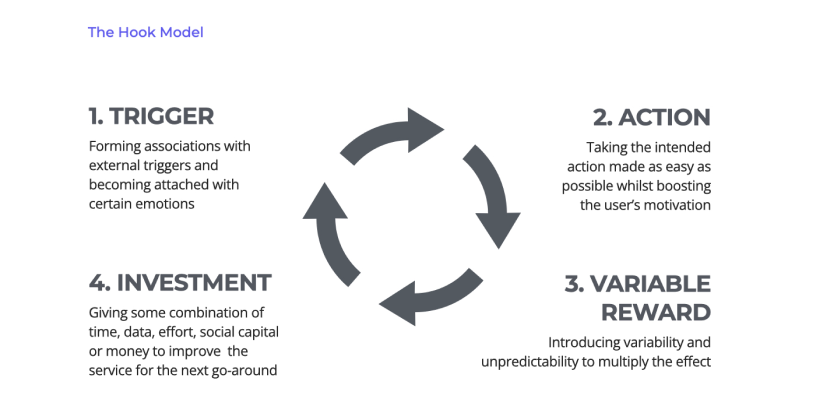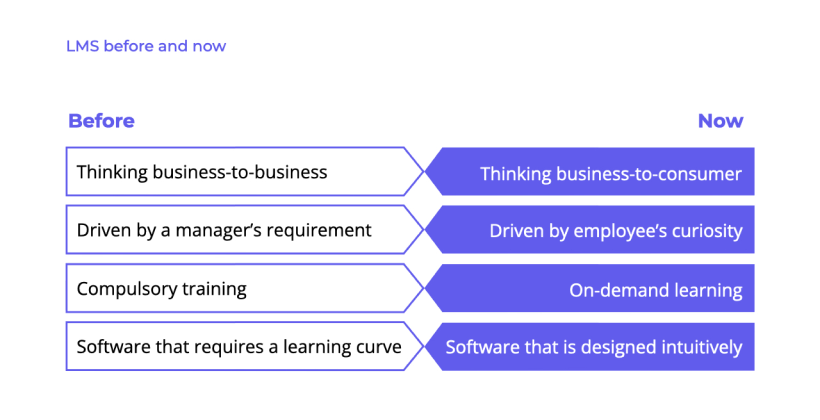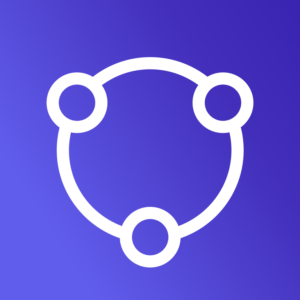
Adopting The Best B2C Practices In B2B eLearning
We all know about the importance of talent Learning and Development, having a direct impact on an internal organizational culture and business bottom line. However, it’s not all sunshine and rainbows—with poor User Experience being a major barrier to smooth employee onboarding. 47% of respondents in our recent survey name user adoption as a top challenge with the Learning and Development within their organization, whilst 85% of employees claimed to be disengaged at work, according to Gallup’s research in 2020.
Add in a global pandemic, the Great Recession, and a whole host of other global concerns, and, well, the mission is clear: we need to get employees engaged again. But how can we do it in the workplace when tech giants like Meta (previously Facebook), Google, Apple, and Amazon have already monopolized people’s attention at home? Learning from the best practice in consumer tech that has set a new standard for User Experience everywhere digital, no matter at work or in life, we explore what techniques and strategies can facilitate company-wide user adoption and consistent engagement in Learning and Development.
New User Expectations, Old Business Practices
Today, too much information leaves us overwhelmed–and yet, we are addicted to content consumption. Social media surely and steadily affects our attention span, but it also gives us a sense of connectivity. Our reliance on technology is altering the way we think, act and engage with other people. In turn, it gives us convenience and freedom that we find hard to give up on. There’s no doubt that technology has changed our behavior and completely revolutionized our lives. As a result of this radical transformation, our expectations have transformed too.
1. Everything Is On-Demand
With Uber, we get where we want, wherever we are, when we want it.
2. Easy And Convenient
With Deliveroo, we get fresh groceries delivered to the door in 15 minutes or less.
3. Great Selection
With Amazon, we choose the most relevant, the most ranked, or the cheapest item from a wide variety.
4. Two-Way Conversation
With Airbnb, we leave a review for the host and get a review as a guest.
User Experience Gap In B2B EdTech
Here comes the tricky part: “The last best experience that anyone has anywhere becomes the minimum expectation for the experience they want everywhere,” says Bridget van Kralingen, senior vice president of IBM Industry Platform. Spotify, Uber, Amazon, and other consumer tech brands follow this principle, constantly improving the User Experience of their digital products and raising our user expectations as a result. But employers often forget to draw this parallel internally. Their employees are users of their enterprise software, too.
According to PwC’s Consumer Intelligence Series, 90% of C-suite executives believe their company pays attention to people’s needs when introducing new technology, but only half (53%) of staff say the same [1]. While 92% of C-suite execs say they’re satisfied with the technology experience their company provides for making progress on their most important work, only 68% of staff agree. How can we reduce this User Experience gap?
Introducing A Habit-Forming Model
To find a potential answer to this niggling question, let’s look at the habit-forming hook model developed by Nir Eyal, a former Standford professor and a bestselling author of Hooked and Insdistractable.

The hook model explains the psychology behind our user behavior of getting “hooked” to a certain digital product experience as we pass through a cycle of four phases: a trigger to begin using the product, an action to satisfy the trigger, a variable reward for the action, and some type of investment—whether of time, effort, data or money—that makes the product more valuable for the next cycle. In the case of Spotify, for example, users go through the following cycle:
- Trigger
The user creates associations of listening to music or a podcast at a time of need, whether at the gym, traveling, or in a focused work mode. - Action
The user easily enters the app and searches specifically for what they want or browses playlists based on the mood, occasion, or time of the day. - Variable reward
The user gets personalized music playlists at least twice a week, in “Discover Weekly” and “Release Radar,” plus other recommendations based on the previous listening history. - Investment
The user puts time and effort into curating their favorite playlists or shares their “Spotify Wrapped” yearly insights on social media, which only adds more value to the next cycle.
Application In eLearning
The hook model has worked for many different consumer tech products and services and defined their success. Of course, some argue that these companies’ success comes at the cost of addictive scrolling and falling down the rabbit hole of content consumption. But can we use this model for good? When learning becomes essential for personal and professional development, this is how we can apply the hook model in eLearning software to facilitate learning in the workplace.
1. Trigger
No employee is the same when it comes to learning, so learning and training managers must accommodate the diverse backgrounds, skillset levels, and development needs of their employees. In an LMS, they can use personalized learning paths to create custom programs for a particular course, certificate, competency, or skill. To draw employees’ attention and engage them for the first time in this learning cycle, create eye-catching banners on the learning platform or approach your learners where they are more likely to instantly respond (e.g. a corporate messenger like MS Teams or Slack).
2. Action
Now, action has to be as easy and barrier-free as possible. With targeted assignments and regular reminders, employees can enroll in a course to complete compulsory training. But to step up to self-learning, employees need a wide course library available at their fingertips and often on the go, with a mobile version and digestible content modules. A simple search button and filter by category, name, or skill helps to explore available learning content and narrow down options with full access to an available course library. Plus, with the help of a built-in authoring tool, learning and training managers can respond to learners’ immediate and long-term needs by populating the existing course library with relevant content.
3. Variable Reward
At this stage, effortless access to content alone cannot be enough. Use and engagement must be consistent. That’s where gamification features come in, including a leaderboard, scoring, or collaborative learning, to motivate employees to stay active. Data analytics and reporting are crucial for learning and training managers to understand how their learners’ activity can be rewarded outside of the LMS. Recognize their effort by connecting learning KPIs to career growth and appraisal opportunities.
4. Investment
Once employees complete their learning cycle, the learning system encourages them to leave feedback. Learning and training managers can assess these reports, take ownership of their team’s training strategy and create more relevant learning as a result. And learners, by investing their ideas, efforts, and time into communicating what training they want next, are now inclined to come back for a more personalized and engaging learning experience. They save their time from unnecessary cycling through irrelevant titles and access the learning they need to improve their job performance and grow their expertise, feeling more connected with their employer too.
What Defines A Modern-Day LMS?
A modern-day LMS doesn’t only compete with other learning platforms but also with the likes of TikTok, YouTube, Facebook, and Instagram. That’s why it’s important to apply the same engagement strategies and User Experience practices in eLearning that can stand the fight for attention at work with consumer tech goliaths.

To do this successfully, a modern-day LMS:
- Thinks business-to-consumer first, even when business-to-business defines its market focus.
- Drives an employee’s curiosity that occurs intrinsically without a manager’s top-down requirement.
- Extends beyond compulsory training to on-demand learning that employees can voluntarily access wherever they are, whenever they want it.
- Doesn’t require a learning curve, accompanied by necessary guides, training sessions, help desk information, and how-to tutorials, but is designed intuitively with the user in mind.
References:
[1] Our status with tech at work: It’s complicated
Image Credits:
The images have been created and supplied by My Learning Hub.
